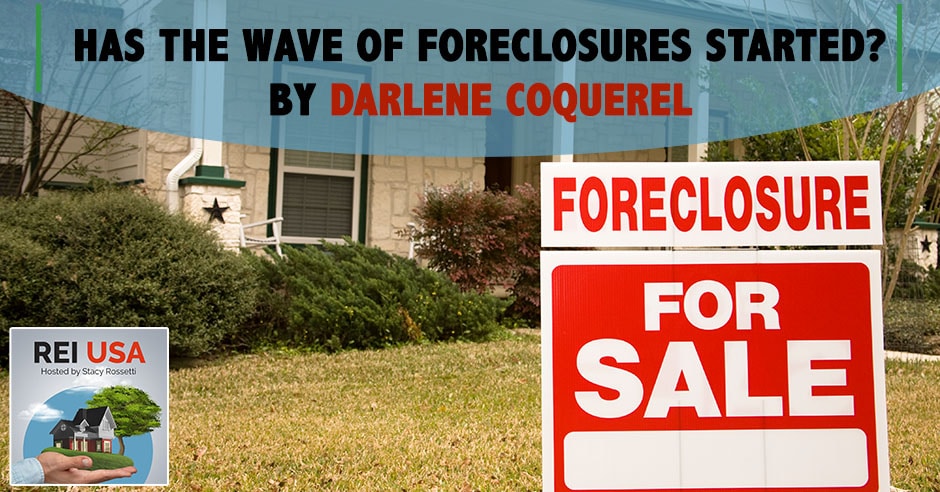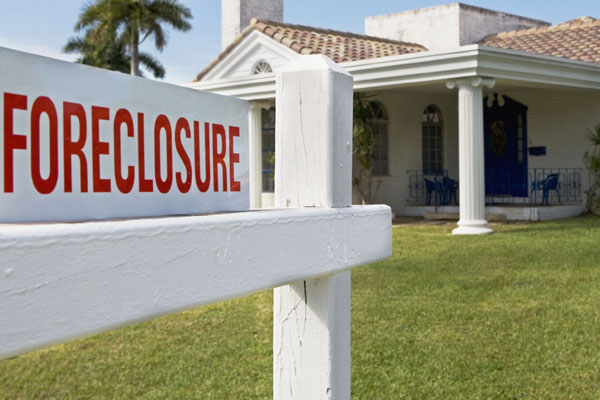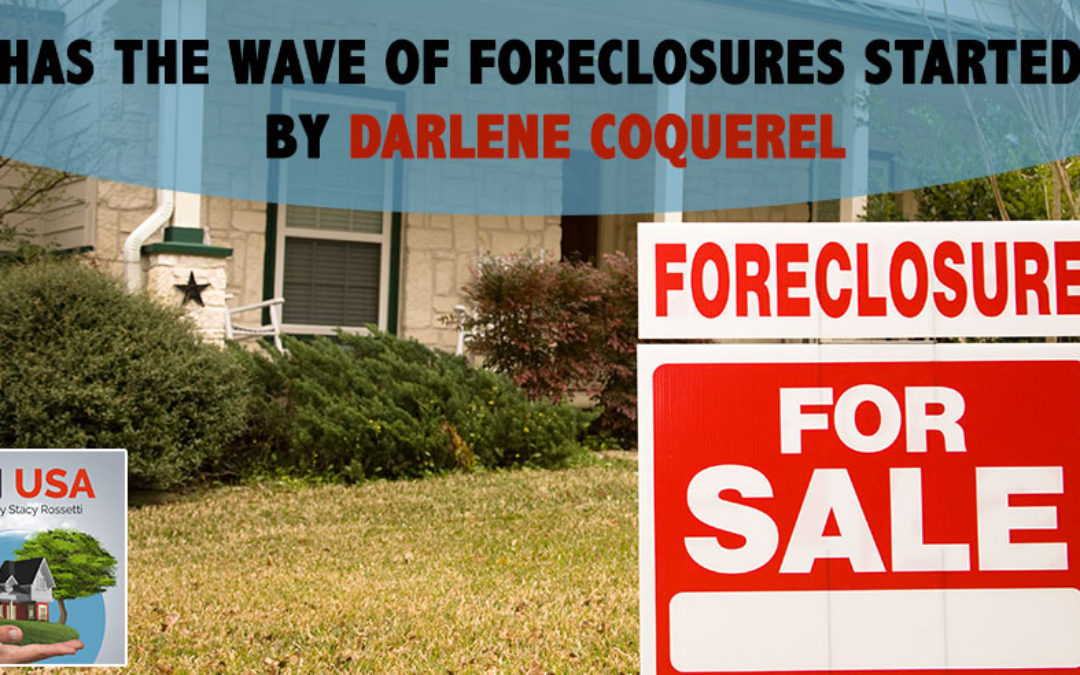
You have to be very strong and consistent to be able to win. The pandemic has affected real estate businesses and homeowners in many ways. Now that we are near the end, is a wave of foreclosures coming to America’s real estate market? Stacy Rossetti invited over Darlene Coquerel to figure this out. Darlene goes over history, statistics and data to help you figure out how to deal with today’s market. Tune in and learn more about the post-pandemic real estate world and how to make your mark.
—
Watch the episode here
Listen to the podcast here
Has The Wave Of Foreclosures Started? By Darlene Coquerel
I’m going to talk about the wave of foreclosures that is coming. There are some bullet points here that I’m going to cover, unfortunately, very briefly. As Stacy said for REI USA, I do lead the Ultimate Foreclosure Formula Supergroup. When it comes to foreclosures, that is something we hear about all the time, but what we do not hear about is that there are three stages of foreclosures. You have to understand the process and how to operate at any given stage.
Educate Yourself On Foreclosures
As Linda said, you never want to go out there at the auctions and buy if you do not know what you are doing because you could put your foot in a snare and get yourself stuck into a situation that is, unfortunately, going to cost you money rather than make your money. Learning foreclosures and teaming up with a good foreclosure team is important. That is why I’m here. We do a lot of joint ventures with students.
I love that REI USA has all of these training that we do, the supergroups and the summits. It is all on the website. As a member, that is your second responsibility. One thing is showing up here. Another thing is to go back there and plan your education time whether it is in the evening, the morning or the middle of the night. Go on there and take advantage of all the free education that comes along with your membership.
I am going to talk briefly about the three stages of foreclosures before I get into the wave of foreclosures in 2022. Stage 1 is Preforeclosures. This is dealing directly with homeowners. Each stage is a little bit different. You are either a judicial state or a non-judicial state. Either way, there is a listing or advertisement that the foreclosure is coming. When you know that the foreclosure is coming, that is your pre-foreclosure list.
[bctt tweet=”You never want to go out there at the auctions and buy if you don’t know what you’re doing.”]
When we deal directly with homeowners, we are looking at subject to deals, short sales and possible lease options. There is not a whole lot with pre-foreclosures or all cash at closing. Subject to and short sales are the first things we look for when we deal with pre-foreclosures. If you are in the business or you want to get in the business and look for motivated sellers, pre-foreclosure is a great niche to add to what you are already doing or learn and take that route in working with motivated sellers.
I spent a lot of time in pre-foreclosures. When the market is like it is now, which means a lack of inventory, you cannot go to the steps, buy properties and get REOs online in Stage 2 and Stage 3 because the pipeline is closed. There are not any coming. We will talk about that. You go back to basics and deal direct-to-seller. That is what we are doing now. We have been doing that for a few years.
I did that around 2009 after the collapse or The Recession of 2007 and 2008, we did not deal with pre-foreclosures anymore because we were shooting fish in a barrel buying at the steps and buying REOs. I will show you where that is going to be in our future. Now, it is not there. Stage 2 is foreclosure. What happens is if a borrower is in default and the borrower for whatever reason is not able to stop the foreclosure then it goes to the courthouse steps or inside the courthouse to be auctioned off depending on the judicial or non-judicial process for your state.
That is legal closure. What happens at that stage is the lender takes ownership of the asset. Up to that point, they are just the lender. They have a cloud or lien on the title but they do not own the asset. They have to take ownership of the asset. In Stage 2, they sell that to a third-party investor or a new owner occupant. If the property is not sold, it goes into Stage 3 and back to the bank. When it goes back to the bank, as a real estate investor, we can buy their REOs or Real Estate Owned.
We can buy REOs directly from the bank. Typically, those are on auction platforms. I got an award in 2014 from Auction.com. I led a team where we purchased over $75 million worth of houses on the REO auctions. Our biggest day ever was 252 houses at the foreclosure auction. That is because we did Houston and Dallas, Texas and Atlanta, Georgia. We operated in about 35 counties buying at the steps. You got to know what you are doing.
There is a lot of due diligence to buy a property at the steps. As new investors, you are looking at Stage 1 and Stage 3 primarily. Here is a little bit about my background. I have 30 years in the business and I bought my first property in ‘91. It was a HUD foreclosure. That means it went through Stage 1, Stage 2, Stage 3 and the bank. It is because it was an FHA loan that HUD pays the bank off and the insurance and then it becomes a HUD foreclosure. My third property in the early ’90s was a VA foreclosure.
If you look from 2005 until 2021, the blue bars represent the number of foreclosure filings in the United States. We are at an all-time low. It is an artificial low because the government intervenes and because of the pandemic. On the right-hand side, 2021 says that we had 151,000 foreclosures across the country, which is amazingly low and then go back to 2019, there are 493,000. In the pre-pandemic immediately before 2020, there were over 500,000 foreclosures.

Foreclosures: Historically, the real estate cycle is said to be about eight years. That means that about two years of that cycle is a strong market.
That is about five times where we are now. Keep going to the left from 2019, 2018, 2017, 2016, all the way up to 2010. In 2010, there were almost 3 million foreclosures. In the blue bar, you see the numbers. Let’s look at 2010. The percentage at the top represents the number of foreclosures against the number of houses. That was almost 2.25% of all the houses in the United States. At the height of the market, almost 2.25% were in foreclosure.
Do I think we are going to get to that number again? That was huge. That was after the collapse of 2007 and 2008. I don’t think our values will drop as they did before. I will tell you why. If I go back all the way to the left side in 2005, there were 500,000. Look at 2005 and compare it to 2019. It is very similar. That looks almost like a norm. If you look at 2005 and then go each direction, the next year went up to 700,000. The year before ‘19 was up to 600,000 and then 676,000. There is a pattern or a cycle.
The Real Estate Cycle, Explained
We will talk a little bit about that. Historically, the real estate cycle is said to be about eight years. That means that about two years of that cycle is a strong market. The prices are increasing. It is a strong seller’s market. The values are going up but then it is usually followed by 5 or 6 years of a decreasing or softer market. In some cases, there is inflation. In some cases, the market crashes. We have had an economic and real estate crash. The cycle happens. We have had an interruption in our cycle.
We normally have an eight-year cycle. Our interruption, in my opinion is because Wall Street, also known as hedge funds when we talk about real estate, has decided that single-family houses are a brand-new asset class for investing. What I say is Wall Street is not going away. They are not leaving. We have completed our first decade with Wall Street in our arena or space. What is going to happen? We cannot predict the future but I can tell you that there are a couple of things.
One, it is difficult to compete against them. They pay crazy stupid money that we should not be paying. Two, they are buying houses and turning them into rentals. We now have a shortage of houses. That shortage in houses in major metropolitan areas where they are buying it is not going to improve rapidly. Those guys, once the foreclosure pipeline opens up, are going to be at the steps in force and buying REOs in force. We are still going to have a shortage along the way.
What is going to happen? I’m not quite sure. Is the government going to intervene and incentivize builders to build neighborhoods that only owner-occupants can buy-in? There is now a relationship between builders and hedge funds where they are coming together and building neighborhoods for rental properties. Something is going to change in the next five years. I’m not quite sure what that is going to look like. In the part of the cycle we are heading, there is going to be a downturn in the cycle.
[bctt tweet=”A follow-up is the most important thing that you can do after you get out there and find motivated sellers because most of the offers we make are not accepted or consummated on the first offer. It happens over time.”]
In some states and areas, you are going to have values go down. You got to look at some things like your unemployment rate. The unemployment rate will drive all this. What is the interest rate? The mortgage interest rates will drive values going up and down. Is your population increasing or decreasing? Those are the kinds of stats that you need to get familiar with. When we talk about foreclosure filings, these are default notices, auctions and bank repossessions.
Instead of foreclosing, the bank may offer Cash for Keys to the defaulted borrower and say, “You give me a deed in lieu of the foreclosure. We will give you Cash for Keys to move on and start your new life somewhere else.” There are lots of good numbers here. They are boring if I talk about them but I have got a lot throughout here to talk about. Another thing that has happened in this pandemic period is the average time to foreclose has increased quarterly and annually.
Look at these crazy numbers. US properties that foreclosed in the fourth quarter of 2021 had been in the process an average of 941 days. That is 31 months. That is almost three years, a 2% increase from the previous quarter and 10% from 2020. Depending on where you are or where you want to invest, the states with the longest average time to foreclose in the fourth quarter in 2021 were Hawaii, New York, Pennsylvania, Louisiana and Florida. That is 7 to 8 years that Hawaii takes to foreclose.
This makes for a good pre-foreclosure opportunity but follow-up. When I’m teaching investors, I say all the time, “A follow-up is the most important thing that you can do after you get out there, start finding people and motivated sellers because most of the offers we make are not accepted or consummated on the first offer. It happens over time.” You have to have a good system and tickler file. If you are old school, you get those accordion files that have 12 months and 31 days. You use those and do your follow-up. If you have got a good CRM electronically, that is the database management of your leads.
You set up your alerts and workflow for alerts to let you know when the next action item is due. That becomes extremely important no matter what part of the business you are in. I like to look at the bigger picture. This is about fifteen years’ worth of data right here of the average days to complete the foreclosure. Back in 2007, 2008, 2009 and 2010, you can see that it is 200 days or less. It kept climbing up higher until you got to 2017. There are over 1,000 days for foreclosure.
Are Foreclosures Coming?
Right now, we are at about 941 days on average across the country. The issue is an artificial situation that happened or a one-time event here that is, unfortunately, over a couple of years now with the pandemic. That is going to change. As you listen to the media, people, economists and such talk about, “Is there going to be a foreclosure wave? Is there not going to be a foreclosure wave?” This has to reset and settle itself down. We are going to go back down from 1,000 to 900 days in foreclosure. It is going to be less.

Foreclosures: Life changes and things happen. We have gone through a difficult two years emotionally from a health perspective and losing people early in life that should not have lost their lives.
I don’t know if you know that between the years of 2010, 2011 and 2012, we had the most number of banks close their door doors in history in the United States. That is coming off of The Recession of 2007 and 2008. When a property is in pre-foreclosure, it is in default also known as a nonperforming asset. Banks can only handle so many nonperforming assets. There are many things that affect what they get to do with their money. That nonperforming asset, the bank can only hold on for so long.
The Zombie Foreclosure
They have got to make a change or close their doors. That is what we are seeing. I will tell you more as we go forward, and then there are Zombie Foreclosures. A Zombie Foreclosure is a situation where the homeowner leaves the property after they get the Notice of Default. They expect they are going to lose the house in the pending foreclosure. That becomes a Zombie Foreclosure. Lenders have field managers and asset management teams that are out there constantly driving their nonperforming assets.
When they drive a nonperforming asset and if they can identify that it is vacant or “abandoned,” then there is a certain period and a process they go through. They are going to take possession of that property physically, change the locks, winterize it and eventually push the foreclosure. Zombie Foreclosures are one of the exceptions to the moratorium. When a bank could identify a property as abandoned even if it was an FHA loan, VA, Fannie Mae, Freddie Mac or USDA loan, these are insured loans. Those were the ones that were mostly affected by the moratorium.
[bctt tweet=”For the most part, properties that go to foreclosure the first time don’t necessarily get foreclosed that time. Once again, follow up. If you’re working on foreclosures, a follow-up is very important.”]
For Zombie Foreclosures, the Northeast has 2 of the top 5 states. New York and Pennsylvania had some of the most numbers of Zombie Foreclosures. Things change. People learn from word of mouth, talking to each other, going to church, families, friends and real estate professionals that they do not have to leave. That is part of the reason that we have seen the days of the market and the days of the foreclosure process increasing. People are learning differently than they used to.
What I do now in foreclosures with owners is they are so much savvier than they were years ago. They’re very informed. The metropolitan areas with the highest rate of Zombie Foreclosures are Portland oregon, Fort Wayne, Indiana, Detroit, Michigan, Cleveland, Ohio and Honolulu. This is what I do. I look at all this stuff and think, “Where is a good place?” If you are beyond your state borders and your model to invest, this is the data that you want to look at and figure out.
Where Do You Go To Find Foreclosed Properties?
This is going on during the moratorium. Imagine what is going to happen after these lenders start foreclosing. States with the highest foreclosure rates in 2021 are Nevada, Illinois, Florida, New Jersey and Delaware. If you go to the top ten, you also include Ohio south Carolina, Indiana, Connecticut and Maryland. In my opinion, these are going to be Zombie Foreclosures where people left the house, reversed mortgages and everything except owner-occupied, FHA, VA, Fannie, Freddie and USDA loans.
Those were the ones that got put on hold. Those are not the ones that we see in foreclosure. We are seeing the others. These are the biggest states. Once again, as soon as the insured loans start foreclosing then they are going to see even bigger numbers. Linda says she talked to a friend in Long Island. He told her that there were abandoned houses where the entire family died of COVID and no one knew how to handle them. That is a list to get, not to be cold or anything.
The MSA is called the Metropolitan Statistical Area. I say this because I was on the front lines. Back in 2007, 2008, 2009 and 2010, the big guys and hedge funds were looking at Fulton County as the MSA for Atlanta. Fulton County is not representative of Atlanta. That is where the Atlanta seat is inside Fulton County. It is interesting because Fulton in Texas has more counties than 35 states combined but our MSA is about 19 to 21 counties. What is your MSA? What makes up your metropolitan area?
The MSAs with about 200,000 in population with the highest foreclosure rates are Cleveland, Ohio, Las Vegas, Lake Havasu, Arizona, Peoria, Illinois and Atlantic City, New Jersey. Those with a population over a million are Cleveland, Las Vegas, Miami, St. Louis and Jacksonville. Even in the first round, Florida was huge on the number of foreclosures. Unfortunately, being in such a litigious state was difficult for the lenders to get their foreclosures through the pipeline.
There is something that started in Florida and maybe California where there were lawsuits against the lenders for wrongful foreclosure. It all goes back to robo-signing. There are a lot of things to know when it comes to working with these. We have got high-level takeaways. There were a total of 56,000 properties, property filings and foreclosure filings in the fourth quarter of 2021. That was up 23% from the previous quarter. Remember, we had the forbearance and the moratorium.
That is why it is such an increase even though we are at an all-time low. It is 82% from 2020. In the pandemic, we are seeing increased percentages but the numbers are very low still. States with the highest foreclosure rates in the fourth quarter of 2021 are Illinois, Florida, New Jersey, Nevada and Ohio. It looks like those guys keep leading the pack here. I said, “That’s a list to get.” You’ve got a house where everybody in the household died because of COVID. The house is vacant and nobody knows. I haven’t even thought and heard of that.
It is interesting to figure out how to find different properties like that. We are always looking for distressed properties, vacant properties and motivated sellers. I told you at the end I would give you a free gift. It talks about getting started in this. One of the things is how to talk to them. What Linda was teaching, I agree. For years, I used postcards for my mailing and pre-foreclosures. Every month somebody would yell at me because you are putting their dirty laundry out there.
I have used envelopes and pre-foreclosure mailing letters rather than postcards because I am sensitive to their business not wanting the post person and, even worse than that, whoever is taking care of finances in the household. A lot of times, the rest of the household does not even know the house is in foreclosure. We found that many times. Here are other takeaways. Nationwide in December 2021, 1 in every 7,647 properties had a foreclosure filing.

Foreclosures: When it comes to foreclosures, there are three stages. Now is the time to focus on Stage 1 and deal directly with homeowners.
That seems like a high number but in the height of the market, we are talking 200 or 1 in every 100 in certain areas of Michigan, New Jersey, New York, Florida and Georgia. It is insane. If we are going back in that direction, I don’t know how high we are going but you can still see over and over again the same states are showing up here. Go to the third bullet point. Nine thousand one hundred sixty-five US properties started the foreclosure process in December 2021. Look at the fourth bullet point. Lenders completed the foreclosure process on 3,093. 1 out of 3 got foreclosed on.
Sixty-five percent or 2 out of 3 did not go to foreclosure. As I looked at my numbers over the years, what I came up with was two. It has always been, for the most part, properties that go to foreclosure the first time do not necessarily get foreclosed that time. Once again, follow-up. If you are working on foreclosures, a follow-up is very important. Even when we make offers on the foreclosure auctions, that property comes around again and again.
I teach that time changes things. When you are looking at HUD, lenders and Freddie, those guys look at their quarterly numbers. They look at their numbers by the quarter. In this quarter, they may not want to take a big loss so they do not sell the property for less than the reserve. The reserve represents some number according to the debt that is owed on the property and the loan that got foreclosed. They do not want to drop it.
If you go bid on the property, the reserve is here. If that highest bid is lower than the reserve, they do not sell it. Come the end of the quarter or the next quarter, they decide they are going to sell it even for a lower amount. It is amazing how that happens but it happens all the time. The end of the year is a good time or 12/31. If they have not sold property all year and they want to get it off their books in the same year, a lot of times, they will fire sale those properties where they would not take a higher price a quarter ago. Those are the things to watch when you are looking at foreclosures.
Will there be an increase in the number of foreclosures in 2022? Here is a quote from an article, “Foreclosure starts are very likely to rise over the next six months to a year.” At the bottom bullet, Wells Fargo and several other big banks stopped all their foreclosure-related activity on occupied properties through the end of 2021, even though the moratorium ended and they could have. There are particular cases where they still foreclosed but, in most cases, they stopped everything.
[bctt tweet=”We will start seeing foreclosures begin to increase in spring 2022. The numbers have been unbelievably low. We will start to see them increase en masse.”]
We are going to see that start back up. Additional safeguards were put in place, like the CFPB or the Consumer Financial Protection Bureau, to smooth the transition from the pandemic, “Let’s halt all foreclosures for borrowers to start making payments again.” They put new rules to guide the lenders on how to work with borrowers to avoid foreclosure. Unfortunately, habits are hard to break. The forbearance allowed borrowers to stop making payments.
Life changes and things happen. We have gone through a difficult two years emotionally from a health perspective and losing people early in life that should not have lost their lives. It has been devastating for us as humans. We have gotten into the habit of not making our payments. You have to turn around and start making your payments. A certain percentage of those forbearance households are not going to make it. That is getting ready to happen.
There is the today and forward and whatever happens today and forward. If I look at history and history will repeat itself in the cycle then there is a certain number of people or homeowners in foreclosure that are going to go into foreclosure that does not even count these past two huge buckets of moratorium foreclosures and forbearance foreclosures. In the third bullet, mortgage delinquency rates showed signs of improvement in August.
BlackKnight said, “There are still serious delinquencies. Those are borrowers more than 90 days behind. They will triple their pre-pandemic levels.” It is going to go back and look at that graph. You will figure out how the next 5 to 10 years are going to play out. At the bottom, “Delinquencies are on pace to return to their pre-COVID levels by early 2022.” I don’t agree with that. We are talking about more delinquencies to go back to the pre-pandemic. We are looking more like 2023.
When Will Foreclosures Start Up?
I will talk a little bit about that. When will foreclosure start back up? If we take into consideration, there were 4.5 million to 5 million people who went into forbearance. At the beginning of forbearance, you had to be current on your loan. If you were current, talk to your lender and say, “I’m affected by COVID,” then they would put you into forbearance. You had 6 months that turned into 12 months and 18 months. The longest I have seen is 20 to 24 months in forbearance.
Those were the ones that were current and then stopped making payments. At least 1/2 or 3/4 of those will keep their houses. At least 1/4 of those would go into foreclosure. Twenty million people face eviction. More than 6 million are unemployed. These are the massive factors that are going to cause people to move out of their homes. This is what is going to cause the foreclosures to increase. Forbearance started in March 2020 with the first payment of April.
You could stop your payments starting April, May, June, July 2021 and so on. The last extension was in August or October 2021. It extends through March of 2022. The last payment in forbearance that is still out there is still March of 2022, even though some started in March 2020. Those folks are done. If you did not start your forbearance until the end of 2021’s last or third quarter, you have until March of 2022 before you have to start making your payment again.
What changes in your life? What happens in your life? Are you unemployed? Are you unhealthy? Have you gone through devastation? All of that plays into what we are going to see in the near future in 2022 and 2023 for foreclosures. In the third bullet down there, I predict that we will start seeing foreclosures begin to increase in spring 2022. The numbers have been unbelievably low. I believe we will start to see them increase en masse.
Start looking around the third quarter. We are going to see that chart or graph going up again. By 2023, we will begin seeing many homeowners displaced again. My prediction is ’23, ’24, ’25 and ’26 are those big numbers like we saw after 2008. We saw 2009, 2010, 2011 and 2012 as those big numbers. It is from 2023 to 2026. I have twenty years, big and wide, in foreclosures and 30 years in the business, with the majority of my business being foreclosure-related.
What is going to happen? Why do I believe these are going to happen? With the number of days of foreclosure, the banks cannot afford that to keep happening. That is going to go back down. Once the government intervention stops, the pandemic is “behind” us and life gets back to some new normal then the number of days in foreclosure will go down. That will automatically start the increase in the foreclosure pipeline because there are so many defaulted loans sitting in that pipeline waiting to pop.
I believe that starting from 2023, we are going to go back to a pre-pandemic normal. Ignore ’21 and ’20, look at ’19 and go backward. If you look at 2005, we were at the bottom. We went to the top of the graph and then went back down to the bottom over fifteen years. Let’s look at 2022 as being like 2020 and then ’23 and ’19, ’24 and ’18 and ’25 and ’17. We are going to start seeing that graph go back up. This is the picture to take. This is what I’m showing you for the next 5 to 6 years that I believe is going to make a change. It is inevitable and the cycle of real estate. It is the economic cycle.
Now is the time to prepare for the tsunami. You got to understand that when it comes to foreclosures, there are three stages. Now is the time to focus on Stage 1 and deal directly with homeowners. I have a free eBook for you. It is clear. It will give you the easy steps to get started with $250. Learn how to speak to owners, find the list and work with them directly. In Stage 2, most people here are not going to go buy properties at the foreclosure auction unless you are already in the business, you know what you are doing or you have aligned yourself with a team that is already buying at the foreclosure option.
Stage 3 is simple. You want to do this. You want to go to Auction.com and HUDHomeStore.com and start looking at REOs in your market so that you can start looking at online auctions. I did my foreclosure supergroup. I showed you some samples of online auctions and bid on one of the properties. If the auction is not over yet, you want to get in and start bidding. There is a lot of work to do. Don’t do it blindly. You got to do it in a smart way.
“How do you locate an online NOD list, which is Notice of Default or what I always need to go to the courthouse?” There are many different ways. Let me give you Support@DarBuysHouses.com. Remind me I was at the Badass Women Summit REI USA and ask me whatever questions there. We are going to relate to individual states. You can go to different list providers. Any good agent in your area has access. Most of the MLS have foreclosure notices.
You want to type your state in Google and ask what is the foreclosure process in Texas, Delaware, Arizona or wherever you are and start looking and doing some research on that. Each state is a little bit different. In Georgia, we have a listing that goes in the legal newspaper of every county four weeks before the auction. Lisa, you are in Texas. You also have the same system. There is what is called a legal organ. Each county has one newspaper that is the legal organ.
Your divorces, deaths, weddings, foreclosures, bankruptcies and all of that are done in your legal organ. You can get your list there. In Georgia, we buy a list from Equity Depot. In Texas, there is the Roddy Report. I don’t know if that’s statewide or just Dallas. I’m not quite sure what part of Texas that is. They have changed over the years, merged and became somebody else. What you do is google that question because each area is a little bit different.

Foreclosures: We have ways of dealing directly. Sometimes they’re mean to us but eventually, they come around.
My website is UltimateForeclosureFormula.com. If you go on my website and scroll down, you will see Preforeclosures. Put some information in there. There is each state you can pull up information from. If you can’t figure it out, hit me up at Support@DarBuysHouses.com. This is one of those lists you do not get at the courthouse. Even during the pandemic, moratorium and forbearance, I still did my pre-foreclosure campaigns.
Finding Deals
I do direct mail. We also do skip tracing and send out text messages, email blasts or emails to whatever we are able to gather. We do not say foreclosure in our texting and our emails because everybody knows that when you do skip tracing, you are going to get up to ten phone numbers. Only one of them may be that person or nobody and I don’t want to put that business out there. We are very kind that way. We try not to be rude and obnoxious.
On the pre-foreclosure piece, it is a letter that says, “This is Darlene. I have been working with family space and foreclosure for many years. We buy houses. We can pay you part of your equity and stop the foreclosure. If you want to keep your house, call us.” I do have DarStopsForeclosures.com. You press a button and they put in all their information. It is the same as my lead sheet or property information sheet. It is all the questions I want them to answer.
When we deal directly with homeowners, we say, “I’m so sorry. What is your situation? Tell me what happened. What do you want to happen?” We shut up and basically, “I want to get this foreclosure off my record. I don’t care if I make a penny. I don’t want the foreclosure. I need money to move. I’m looking for $10,000 and trying to sell my house. I would like to keep my house.” Those are your typical answers.
In pre-foreclosure, we go back with, “Would you be willing to sell your house for what you owe on it?” That is our number one subject to question, “What do you mean? I owe $60,000. My house is worth $250,000.” “That is what I’m asking. Would you be willing to sell it for the $62,000 you owe on it?” “No. I have got all that equity.” “How much cash do you need at closing?” We go onto, “Tell me a little bit about the house and so on. If we can make this work, get you $10,000 at closing and reinstate your loan, would you be willing to close with us?”
We have ways of dealing directly. Sometimes they are mean to us but eventually, they come around. This is Ms. Suelyn here. She is crying at the closing table. This was the closing attorney’s office. She says, “You are not in it by yourself. I now have peace of mind and a new outlook in life.” Instead of having a foreclosure, we stopped the foreclosure and took the property subject to, she got $3,000, we helped her move and said, “Leave everything that you do not want.”
A subject to is one of our favorite short sales. It is also part of the pre-foreclosure Cash for Keys. I mentioned that we had a lender that was willing to give $10,000 in Columbus for relocation assistance on a short sale. Learning how to work that process is helpful and finding motivated sellers. There are many different ways. You could do direct mail, email, outbound calls, texts, calls, driving for dollars and door knocking. We do all of this.
I believe that the business, depending on where you are is out there finding the deals that are not on the radar. If they are in pre-foreclosure, you want to talk to them. If they are in probate then you can go find them that way. If they are an abandoned house or a vacant house, those are what you want to do because for the ones that are on MLS, Zillow for sale by owner or in auctions, it is difficult to compete. You got to be very strong and consistent to be able to win.
This is the free eBook. All you need to do is text eBook to this phone number (408) 539-3006. I will give you the five easy steps to start investing in real estate. Go get your cellphone and do it. It is good stuff. It is the basics. When I teach real estate investors, we all want to make it more complicated than this but it is the five basic steps to get started. Once you get there, we pretty much try to help anybody in the game. If you are in the REI USA group and we talk on Facebook or however you want to talk, we will help you get there. We bring some expertise to the table.
We have a lot of students in different states, even in Georgia that we joint venture with. If you know how to get some folks that need to sell their house, you’ve got to build your dream team. Find somebody that you can work with. As Stacy said, “Darlene is going to tell you.” If you like this, this is all I ever do and it is more of the same. Come to the supergroup and mark your calendar on the fourth Tuesday of every month at 7:00 Eastern Time. I will drill down. If I know in advance that somebody is showing up and they want to talk about Stage 1 or Stage 3, we will spend the night speaking on that subject.
Important Links
- REI USA
- Auction.com
- ATTOM
- RealtyTrac
- Year-End Outlook: A Tick to Torrent of Foreclosures Expected in 2022
- CFPB
- HUDHomeStore.com
- Support@DarBuysHouses.com
- Badass Women Summit REI USA
- Equity Depot
- Roddy Report
- UltimateForeclosureFormula.com
- DarStopsForeclosures.com
- Zillow
- REI USA – Facebook group
- http://www.rei-usa.com/membership/
- http://www.REI-USA.com/trainings/
- http://www.REI-USA.com/ teachers-spotlight/
- http://www.rei-usa.com/free-template/
- https://www.instagram.com/reiusa_/
- Free Online Jumpstart Course for Real Estate Investing: https://bit.ly/3IrDji9
- REI USA Youtube: https://bit.ly/36QPoQl
- How to Get Started Investing in Real Estate: https://bit.ly/3pIxB4r
- Talk to Kristi, Our Community Manager, for a FREE 10 Minute Website Demo: https://bit.ly/3pIxB4r
About Darlene Coquerel
 Darlene Coquerel, Queen of Foreclosures and Founder of Ultimate Foreclosure Formula has been investing in real estate since 1991. She got her real estate license in Georgia in 1991 and is successful in all aspects of residential real estate. It took Darlene a year to get her first property under contract and she’s been working with foreclosures in all 3 stages ever since!
Darlene Coquerel, Queen of Foreclosures and Founder of Ultimate Foreclosure Formula has been investing in real estate since 1991. She got her real estate license in Georgia in 1991 and is successful in all aspects of residential real estate. It took Darlene a year to get her first property under contract and she’s been working with foreclosures in all 3 stages ever since!
In 2014, Darlene was the recipient of the Platinum Investor Award from Auction.com when her team acquired over $75,000,000 worth of houses that year from the auction.com online platform. Darlene rolls with the punches when the market changes and focuses on the stage of foreclosure to go along with the market conditions. She is currently focusing on buying Preforeclosures, direct from homeowners, Foreclosures when there’s no moratorium and she will buy REO’s direct from the banks when the foreclosure tsunami hits again! Darlene serves real estate investors worldwide who want to Find Motivated Sellers, Close More Deals and Make Money in 60 days or less!
Darlene currently resides in Atlanta but invests in all markets where the numbers make sense. Her superpower is to facilitate a super team and is always looking for new players to add to her team.

